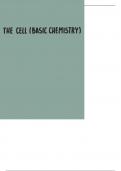THE CELL /BASIC CHEMISTRY
, THE CELL /BASIC CHEMISTRY
CHEMICAL ELEMENTS
that takes up space and has
anything
matter= mass
↳
different forms four distinct states solid , liquid plasma
many
:
, ,
gas ,
)
↳
composed of elements - >
substance that can't be broken down into simpler substances
each element has specific unique properties (e
, .
. density
g ,
solubility
,
melting point .....
building blocks of matter bother
92 elements elements
naturally occurring =
-
by physicists (not biologically
relevant
artificially constructed
six elements basic to life =
C , H ,
N , 0 ,
P, S
make up 95 % of
body mass of
organisms , essential to uniqueness of
cells/organisms
also important to life k Ca , Fe , zn
Mg
=
, .
John Dalton developed atomic elements are composed of particles called atoms
theory
=
atom is smallest part of element that still
displays properties of that element
(one letters
atomic
symbol stands for name or two
=
atoms consist of subatomic particles protons ( ) neutrons electrons (-)
:
+
, ,
↳
protons and neutrons in nucleus , electrons more around it in electron shells
all atoms of same element have same
number of protons =
atomic number
atoms are assumed to be of protons/elections
electrically neutral number
-I
same
sum of protons and neutrons =
mass number
each atom has same atomic number , but number
of neutrons can
vary
=
isotopes
atomic of all isotopes of atom
mass=aug .
mass
to determine number of neutrons from atomic mass
>
subtract protons from atomic mass take closest whole number
-
,




